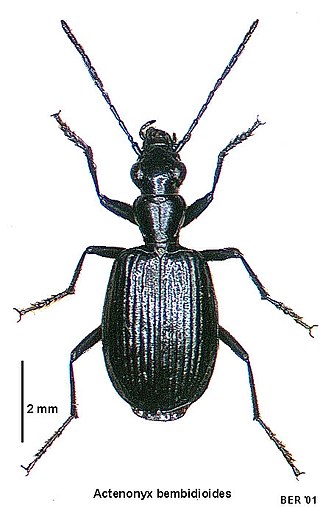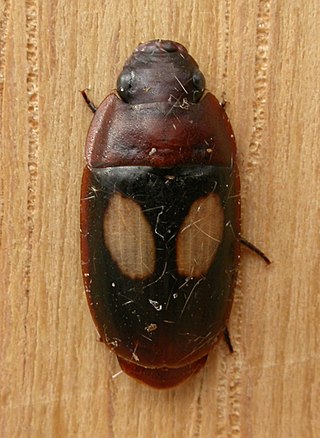
Harpalinae is the largest subfamily of ground beetles, containing more than 19,000 species worldwide.

Calathus is a genus of ground beetle native to the Palearctic, the Near East and North Africa. There are at least 190 described species in Calathus.
Agra katewinsletae is a species of carabid beetle named after English actress Kate Winslet.
Agra liv is a species of carabid beetle found in Costa Rica and Panama. It is named after the actress Liv Tyler, starlet of the movie Armageddon, because the "existence of this species of elegant beetle is dependent upon the rainforest not undergoing an armageddon."
Agra schwarzeneggeri is a species of carabid beetle. It is named after the actor Arnold Schwarzenegger. The holotype was collected in Costa Rica and first described to science in 2002.

Cis is a genus of tree-fungus beetles in the family Ciidae. There are at least 150 described species in Cis.

Guatemalteca is a genus of beetle in the family Carabidae. As of 2017, its only described species is its type species, Guatemalteca virgen. When Terry Erwin named the genus in 2004, he placed it in the tribe Lachnophorini; in 2014 he and Laura S. Zamorano placed it in the subtribe Eucaerina.

Actenonyx is a genus of beetles in the family Carabidae. At present only species in this genus is Actenonyx bembidioides. However, it has been suggested that a taxonomic revision of this genus is needed as there are two species that await description. This genus and species was first described by Adam White and is endemic to New Zealand.

Pseudomorphinae is a subfamily of ground beetles in the family Carabidae. There are about 12 genera and at least 360 described species in Pseudomorphinae.
Halocoryza is a genus of beetles in the family Carabidae, containing the following species:

Tasmanitachoides is a genus of ground beetles in the family Carabidae, endemic to Australia. The beetles are very small, typically 1.5 to 3.0 mm. in length, and live in coarse sand or fine gravel along freshwater shorelines throughout Australia.
Agra catbellae is a species of carabid beetle named after the actress Catherine Bell. The holotype was collected in Costa Rica and first described to science in 2002.
Agra solanoi is a species of carabid beetle. The holotype was collected in Costa Rica and first described to science in 2002.
Agra dable is a species of carabid beetle. The holotype was collected in Costa Rica and first described to science in 2002.
Beulah Garner FRES is an entomologist in the United Kingdom. She is Senior Curator at the Natural History Museum, London and is an expert of beetles, in particular the ground beetles (Carabidae).
Agra solisi is a species of carabid beetle. The holotype was collected in Costa Rica and first described to science in 2002 by Terry L. Erwin.
Agra santarosa is a species of carabid beetle. The holotype was collected in Costa Rica and first described to science in 2002 by Terry L. Erwin.
Agra aurifera is a species of carabid beetle. The holotype was collected in Costa Rica and first described to science in 1940 by Max Liebke.
Agra guatemalena is a species of carabid beetle. The holotype was collected in Costa Rica and first described to science in 1932 by Ernő Csíki.

Bembidarenini is a tribe of ground beetles in the family Carabidae. There are 4 genera and more than 30 described species in Bembidarenini. Three of the genera are found in South America and one in Australia.



















